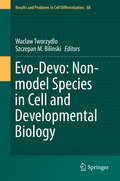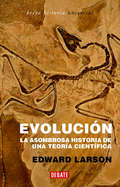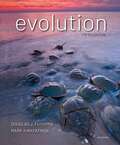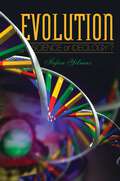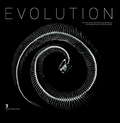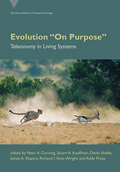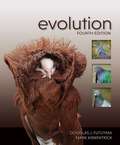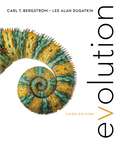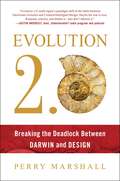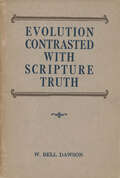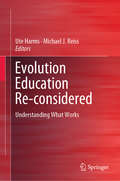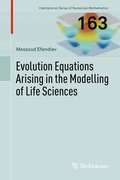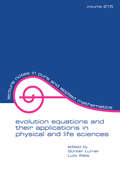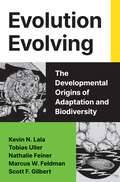- Table View
- List View
Evo-Devo of Child Growth
by Ze'Ev HochbergWorking with principles from the fields of evolutionary and developmental biology (evo-devo), this fascinating work offers a new approach to analyzing child growth and development, examining each stage and transition in detail, from fetal development to preadulthood. Based on the author's in-depth review of the current literature and his own observations as a pediatric endocrinologist, the book demonstrates how the transitions between human life history phases represent unique periods of evolutionary adaptive response to the environment. In addition, the author explains why an understanding of these transition periods enables us to better understand the sequence and mechanisms of child growth as well as to better diagnose child growth disorders. Logically organized and clearly written, Evo-Devo of Child Growth: Sets a solid foundation of principles such as evolutionary thinking in medicine and child growth, life history theory, and heterochrony and allometry Examines the relationship between child growth and the theory of life history Applies evo-devo theory to fetal growth, infancy, childhood, juvenility, adolescence, and preadulthood Explores the trade-offs and adaptive phenotypic plasticity during transition periods Explains the role of life history theory in understanding and diagnosing growth disorders such as Down syndrome, Noonan syndrome, and Silver-Russell syndrome In addition to the author's own analysis and observations, this book also features notes from leading clinicians and evolutionary biologists, offering additional perspectives on the relationship between evo-devo and child growth and development. Evo-Devo of Child Growth provides a new perspective for evolutionary biologists to understand the phases and transitions of child growth. Moreover, it offers a new approach to help clinicians to better understand and diagnose a broad range of child growth disorders.
Evo-Devo: Non-model Species in Cell and Developmental Biology (Results and Problems in Cell Differentiation #68)
by Waclaw Tworzydlo Szczepan M. BilinskiEvolutionary developmental biology or evo-devo is a field of biological research that compares the underlying mechanisms of developmental processes in different organisms to infer the ancestral condition of these processes and elucidate how they have evolved. It addresses questions about the developmental bases of evolutionary changes and evolution of developmental processes. The book’s content is divided into three parts, the first of which discusses the theoretical background of evo-devo. The second part highlights new and emerging model organisms in the evo-devo field, while the third and last part explores the evo-devo approach in a broad comparative context. To the best of our knowledge, no other book combines these three evo-devo aspects: theoretical considerations, a comprehensive list of emerging model species, and comparative analyses of developmental processes. Given its scope, the book will offer readers a new perspective on the natural diversity of processes at work in cells and during the development of various animal groups, and expand the horizons of seasoned and young researchers alike.
Evo-SETI: Life Evolution Statistics on Earth and Exoplanets
by Claudio MacconeThis book offers a vision of how evolutionary life processes can be modelled. It presents a mathematical description that can be used not only for the full evolution of life on Earth from RNA to modern human societies, but also the possible evolution of life on exoplanets, thus leading to SETI, the current Search for ExtraTerrestrial Intelligence. The main premise underlying this mathematical theory is that the Geometric Brownian Motion (GBM) can be applied as a key stochastic process to model the evolution of life. In the resulting Evo-SETI Theory, the life of any living thing (a cell, an animal, a human, a civilization of humans, or even an ET civilization) is represented by a b-lognormal, i.e., a lognormal probability density function starting at a precise instant (b, birth) then increasing up to a peak time, then decreasing to senility time and then continuing as a straight line down to the time of death.Using this theory, Claudio Maccone arrives at remarkable hypotheses on the development of life and civilizations, the possibility of extraterrestrial life, and when computers will take over the reins from us humans (Singularity). The book develops the mathematical Evo-SETI Theory by integrating a set of articles that the author has published in various journals on Astrobiology and Astronautical Research.
Evolución
by Edward J. LarsonLa teoría de la evolución no nació solo de la imaginación de Charles Darwin. Desde sus orígenes, la humanidad ha buscado sin tregua respuestas religiosas, filosóficas y científicas a la pregunta clave: ¿de dónde venimos? Con la irrupción y el auge de la ciencia moderna, la controversia sobre la cuestión de la evolución de la especie se aceleró hasta alcanzar el grado de precisión científica actual. En esta brillante obra -que combina un maravilloso anecdotario con el rigor académico- el ganador del Pulitzer Edward J. Larson nos conduce a través de la idea de la evolución, desde sus antecedentes teóricos, pasando por los portentosos logros de Darwin y Wallace, hasta llegar al descubrimiento de la doble hélice del ADN llevada a cabo por los profesores Watson y Crick, la exitosa síntesis neodarwinista actual y la extensión de la sociobiología. Al tiempo que traza el camino de las ideas, Evolución describe una galería de personajes fascinantes, los científicos, exploradores y excéntricos cuyas colaboraciones y disputas impulsaron la teoría evolutiva. De Cuvier, Lamarck, Darwin y Wallace a Haeckel, Galton, Huxley y Mendel o Watson y Crick, Larson recorre este dramatis personae consiguiendo un libro que el reputado científico Ernst Mayr calificó de «delicia intelectual».
Evolución: La asombrosa historia de una teoría científica
by Edward J. LarsonUn recorrido por la idea de la evolución, desde sus antecedentes teóricos a la actualidad. La teoría de la evolución no nació solo de la imaginación de Charles Darwin. Desde sus orígenes, la humanidad ha buscado sin tregua respuestas religiosas, filosóficas y científicas a la pregunta clave: ¿de dónde venimos? Con la irrupción y el auge de la ciencia moderna, la controversia sobre la cuestión de la evolución de la especie se aceleró hasta alcanzar el grado de precisión científica actual. En esta brillante obra -que combina un maravilloso anecdotario con el rigor académico- el ganador del Pulitzer Edward J. Larson nos conduce a través de la idea de la evolución, desde sus antecedentes teóricos, pasando por los portentosos logros de Darwin y Wallace, hasta llegar al descubrimiento de la doble hélice del ADN llevada a cabo por los profesores Watson y Crick, la exitosa síntesis neodarwinista actual y la extensión de la sociobiología. Al tiempo que traza el camino de las ideas, Evolución describe una galería de personajes fascinantes, los científicos, exploradores y excéntricos cuyas colaboraciones y disputas impulsaron la teoría evolutiva. De Cuvier, Lamarck, Darwin y Wallace a Haeckel, Galton, Huxley y Mendel o Watson y Crick, Larson recorre este dramatis personae consiguiendo un libro que el reputado científico Ernst Mayr calificó de «delicia intelectual».
Evolution
by Mark Kirkpatrick Douglas FutuymaThe gold standard in undergraduate-level evolutionary biology textbooks. This new fifth edition presents the field of evolution as a living, breathing science. Extensively revised for clarity and currency, Evolution, Fifth Edition, includes updated coverage of evolutionary genetics and genomics to illustrate the rapidly moving science of evolution. It also emphasizes the interplay between theory and empirical test hypotheses, acquainting students with the process of science. Evolution is available in a dynamic interactive enhanced e-Book that helps students hone their problem-solving and data analysis skills while seeing evolution in the context of their life.
Evolution
by Irfan YilmazExamining the evolution debate from different aspects, this study points out the divergent uses of evolution and it posits a scientific argument against the theory of evolution, and includes rational explanations derived from the Islamic understanding of creation.
Evolution
by Linda Asher Patrick Gries Jean-Baptiste De PanafieuUnprecedented in its approach, the number and diversity of the species presented, and the quality of the photographs, Evolution is the book on how we came to be what we are. Spectacular, mysterious, elegant, or grotesque, the skeletons of the vertebrates that inhabit the earth today carry within them the imprint of an evolutionary process that has lasted several billion years. This book is the result of a dual approach, scientific as well as aesthetic, rigorous yet accessible. Each chapter is made up of a short text that illuminates one theme of the evolutionary process--repetition, adaptation, polymorphism, sexual selection, and more--and a series of exquisitely composed photographs of skeletons against a black background. Approximately three hundred photographs of whole skeletons or their details have been made possible by the French National Museum of Natural History. The reader learns, by experiencing each text and photograph together, how the structure of every creature has been shaped by its environmental and genetic inheritance.
Evolution "On Purpose": Teleonomy in Living Systems (Vienna Series in Theoretical Biology)
by Peter A. Corning, et al.A unique exploration of teleonomy—also known as &“evolved purposiveness&”—as a major influence in evolution by a broad range of specialists in biology and the philosophy of science.The evolved purposiveness of living systems, termed &“teleonomy&” by chronobiologist Colin Pittendrigh, has been both a major outcome and causal factor in the history of life on Earth. Many theorists have appreciated this over the years, going back to Lamarck and even Darwin in the nineteenth century. In the mid-twentieth century, however, the complex, dynamic process of evolution was simplified into the one-way, bottom-up, single gene-centered paradigm widely known as the modern synthesis. In Evolution &“On Purpose,&” edited by Peter A. Corning, Stuart A. Kauffman, Denis Noble, James A. Shapiro, Richard I. Vane-Wright, and Addy Pross, some twenty theorists attempt to modify this reductive approach by exploring in depth the different ways in which living systems have themselves shaped the course of evolution.Evolution &“On Purpose&” puts forward a more inclusive theoretical synthesis that goes far beyond the underlying principles and assumptions of the modern synthesis to accommodate work since the 1950s in molecular genetics, developmental biology, epigenetic inheritance, genomics, multilevel selection, niche construction, physiology, behavior, biosemiotics, chemical reaction theory, and other fields. In the view of the authors, active biological processes are responsible for the direction and the rate of evolution. Essays in this collection grapple with topics from the two-way &“read-write&” genome to cognition and decision-making in plants to the niche-construction activities of many organisms to the self-making evolution of humankind. As this collection compellingly shows, and as bacterial geneticist James Shapiro emphasizes, &“The capacity of living organisms to alter their own heredity is undeniable.&”
Evolution (Fourth Edition)
by Douglas J. Futuyma Mark KirkpatrickThe book offers additional expertise in evolutionary genetics and genomics, the fastest-developing area of evolutionary biology. Directed toward an undergraduate audience, the text emphasizes the interplay between theory and empirical tests of hypotheses, thus acquainting students with the process of science. It addresses major themes--including the history of evolution, evolutionary processes, adaptation, and evolution as an explanatory framework--at levels of biological organization ranging from genomes to ecological communities.
Evolution (Routledge Revivals)
by F. B. JevonsFirst published in 1900, this philosophical essay on Evolution questions how the acceptance of Evolution as scientific should influence the thoughts and actions of humankind from the perspective of morality and moral conduct. In his discussion, Frank B. Jevons deals with such subjects as pessimism and optimism towards evolutionary theory, the laws of motion and matter, and the importance of scientific evidence.
Evolution (Third Edition)
by Lee Alan Dugatkin Carl T. BergstromThe most current introduction to evolutionary biology, with an emphasis on anthropogenic evolution and data literacy. A thorough and current introduction to evolutionary biology reinforced by tools that improve learning. Every chapter has been updated to provide a more focused, accessible introduction to core topics reflecting exciting new research, anthropogenic evolution examples, and increased emphasis on building data literacy. These emphases are reinforced by InQuizitive, which was revised and expanded to include more questions that involve interpreting evolutionary data and engaging with contemporary research. This purchase offers access to the digital ebook only.
Evolution 2.0
by Friedel Weinert Martin BrinkworthThese essays by leading philosophers and scientists focus on recent ideas at the forefront of modern Darwinism, showcasing and exploring the challenges they raise as well as open problems. This interdisciplinary volume is unique in that it addresses the key notions of evolutionary theory in approaches to the mind, in the philosophy of biology, in the social sciences and humanities; furthermore it considers recent challenges to, and extensions of, Neo-Darwinism. The essays demonstrate that Darwinism is an evolving paradigm, with a sphere of influence far greater than even Darwin is likely to have imagined when he published 'On the Origin of Species' in 1859.
Evolution 2.0: Breaking the Deadlock Between Darwin and Design
by Perry MarshallIn the ongoing debate about evolution, science and faith face off. But the truth is both sides are right and wrong. In one corner: Atheists like Richard Dawkins, Daniel Dennett, and Jerry Coyne. They insist evolution happens by blind random accident. Their devout adherence to Neo-Darwinism omits the latest science, glossing over crucial questions and fascinating details. In the other corner: Intelligent Design advocates like William Dembski, Stephen Meyer, and Michael Behe. Many defy scientific consensus, maintaining that evolution is a fraud and rejecting common ancestry outright. There is a third way. Evolution 2.0 proves that, while evolution is not a hoax, neither is it random nor accidental. Changes are targeted, adaptive, and aware. You'll discover: How organisms re-engineer their genetic destiny in real time Amazing systems living things use to re-design themselves Every cell is armed with machinery for editing its own DNA The five amazing tools organisms use to alter their genetics 70 years of scientific discoveries—of which the public has heard virtually nothing! Perry Marshall approached evolution with skepticism for religious reasons. As an engineer, he rejected the concept of organisms randomly evolving. But an epiphany—that DNA is code, much like data in our digital age—sparked a 10-year journey of in-depth research into more than 70 years of under-reported evolutionary science. This led to a new understanding of evolution—an evolution 2.0 that not only furthers technology and medicine, but fuels our sense of wonder at life itself. This book will open your eyes and transform your thinking about evolution and God. You'll gain a deeper appreciation for our place in the universe. You'll see the world around you as you've never seen it before. Evolution 2.0 pinpoints the central mystery of biology, offering a multimillion dollar technology prize at naturalcode.org to the first person who can solve it.
Evolution Contrasted with Scripture Truth
by W. Bell DawsonThe main object of these pages is to show that Evolution is incompatible with the vital doctrines of Christianity. It is first necessary to ascertain just what Evolution properly means. If claims are to be maintained, it must explain the development of all that exists, from primary material to life and intelligence. A theory such as Evolution can be judged not only on the ground of evidence, and the need for adequate forces to cause it to operate, but it can also be tested by its outcome. If it tenets when followed out, are found to be subversive of known truth, in morals and religion, the verdict must be against it.When compared with the foundational doctrines of Christianity, it is coming to be clearly recognized that the teachings of Evolution are antagonistic to them. Compromise is not possible unless the vital truths of Christianity are explained away and replaced by Modernist views. It is thus evident that a choice must be made between evolutionary teaching and the Scriptures as a revelation from God.
Evolution Contrasted with Scripture Truth
by W. Bell DawsonThe main object of these pages is to show that Evolution is incompatible with the vital doctrines of Christianity. It is first necessary to ascertain just what Evolution properly means. If claims are to be maintained, it must explain the development of all that exists, from primary material to life and intelligence. A theory such as Evolution can be judged not only on the ground of evidence, and the need for adequate forces to cause it to operate, but it can also be tested by its outcome. If it tenets when followed out, are found to be subversive of known truth, in morals and religion, the verdict must be against it.When compared with the foundational doctrines of Christianity, it is coming to be clearly recognized that the teachings of Evolution are antagonistic to them. Compromise is not possible unless the vital truths of Christianity are explained away and replaced by Modernist views. It is thus evident that a choice must be made between evolutionary teaching and the Scriptures as a revelation from God.
Evolution Driven by Organismal Behavior
by Rui DiogoThis book proposes a new way to think about evolution. The author carefully brings together evidence from diverse fields of science. In the process, he bridges the gaps between many different--and usually seen as conflicting--ideas to present one integrative theory named ONCE, which stands for Organic Nonoptimal Constrained Evolution. The author argues that evolution is mainly driven by the behavioral choices and persistence of organisms themselves, in a process in which Darwinian natural selection is mainly a secondary--but still crucial--evolutionary player. Within ONCE, evolution is therefore generally made of mistakes and mismatches and trial-and-error situations, and is not a process where organisms engage in an incessant, suffocating struggle in which they can't thrive if they are not optimally adapted to their habitats and the external environment. Therefore, this unifying view incorporates a more comprehensive view of the diversity and complexity of life by stressing that organisms are not merely passive evolutionary players under the rule of external factors. This insightful and well-reasoned argument is based on numerous fascinating case studies from a wide range of organisms, including bacteria, plants, insects and diverse examples from the evolution of our own species. The book has an appeal to researchers, students, teachers, and those with an interest in the history and philosophy of science, as well as to the broader public, as it brings life back into biology by emphasizing that organisms, including humans, are the key active players in evolution and thus in the future of life on this wonderful planet.
Evolution Education Around the Globe
by Hasan Deniz Lisa A. BorgerdingThis edited book provides a global view on evolution education. It describes the state of evolution education in different countries that are representative of geographical regions around the globe such as Eastern Europe, Western Europe, North Africa, South Africa, North America, South America,Middle East, Far East, South East Asia, Australia, and New Zealand.Studies in evolution education literature can be divided into three main categories: (a) understanding the interrelationships among cognitive, affective, epistemological, and religious factors that are related to peoples’ views about evolution, (b) designing, implementing, evaluating evolution education curriculum that reflects contemporary evolution understanding, and (c) reducing antievolutionary attitudes. This volume systematically summarizes the evolution education literature across these three categories for each country or geographical region. The individual chapters thus include common elements that facilitate a cross-cultural meta-analysis. Written for a primarily academic audience, this book provides a much-needed common background for future evolution education research across the globe.
Evolution Education Re-considered: Understanding What Works
by Michael J. Reiss Ute HarmsThis collection presents research-based interventions using existing knowledge to produce new pedagogies to teach evolution to learners more successfully, whether in schools or elsewhere. ‘Success’ here is measured as cognitive gains, as acceptance of evolution or an increased desire to continue to learn about it. Aside from introductory and concluding chapters by the editors, each chapter consists of a research-based intervention intended to enable evolution to be taught successfully; all these interventions have been researched and evaluated by the chapters’ authors and the findings are presented along with discussions of the implications. The result is an important compendium of studies from around the word conducted both inside and outside of school. The volume is unique and provides an essential reference point and platform for future work for the foreseeable future.
Evolution Equations Arising in the Modelling of Life Sciences
by Messoud EfendievThis book deals with the modeling, analysis and simulation of problems arising in the life sciences, and especially in biological processes. The models and findings presented result from intensive discussions with microbiologists, doctors and medical staff, physicists, chemists and industrial engineers and are based on experimental data. They lead to a new class of degenerate density-dependent nonlinear reaction-diffusion convective equations that simultaneously comprise two kinds of degeneracy: porous-medium and fast-diffusion type degeneracy. To date, this class is still not clearly understood in the mathematical literature and thus especially interesting. The author both derives realistic life science models and their above-mentioned governing equations of the degenerate types and systematically studies these classes of equations. In each concrete case well-posedness, the dependence of solutions on boundary conditions reflecting some properties of the environment, and the large-time behavior of solutions are investigated and in some instances also studied numerically.
Evolution Equations Arising in the Modelling of Life Sciences (International Series of Numerical Mathematics #163)
by Messoud EfendievThis book deals with the modeling, analysis and simulation of problems arising in the life sciences, and especially in biological processes. The models and findings presented result from intensive discussions with microbiologists, doctors and medical staff, physicists, chemists and industrial engineers and are based on experimental data. They lead to a new class of degenerate density-dependent nonlinear reaction-diffusion convective equations that simultaneously comprise two kinds of degeneracy: porous-medium and fast-diffusion type degeneracy. To date, this class is still not clearly understood in the mathematical literature and thus especially interesting. The author both derives realistic life science models and their above-mentioned governing equations of the degenerate types and systematically studies these classes of equations. In each concrete case well-posedness, the dependence of solutions on boundary conditions reflecting some properties of the environment, and the large-time behavior of solutions are investigated and in some instances also studied numerically.
Evolution Equations and Their Applications in Physical and Life Sciences: Proceedings Of The Bad Herrenalb (karlsruhe), Germany, Conference (Lecture Notes in Pure and Applied Mathematics)
by G LumerThis volume presents a collection of lectures on linear partial differntial equations and semigroups, nonlinear equations, stochastic evolutionary processes, and evolution problems from physics, engineering and mathematical biology. The contributions come from the 6th International Conference on Evolution Equations and Their Applications in Physica
Evolution Evolving: The Developmental Origins of Adaptation and Biodiversity
by Tobias Uller Marcus Feldman Scott F. Gilbert Kevin N. Lala Nathalie FeinerA new account of the central role developmental processes play in evolutionA new scientific view of evolution is emerging—one that challenges and expands our understanding of how evolution works. Recent research demonstrates that organisms differ greatly in how effective they are at evolving. Whether and how each organism adapts and diversifies depends critically on the mechanistic details of how that organism operates—its development, physiology, and behavior. That is because the evolutionary process itself has evolved over time, and continues to evolve. The scientific understanding of evolution is evolving too, with groundbreaking new ways of explaining evolutionary change. In this book, a group of leading biologists draw on the latest findings in evolutionary genetics and evo-devo, as well as novel insights from studies of epigenetics, symbiosis, and inheritance, to examine the central role that developmental processes play in evolution.Written in an accessible style, and illustrated with fascinating examples of natural history, the book presents recent scientific discoveries that expand evolutionary biology beyond the classical view of gene transmission guided by natural selection. Without undermining the central importance of natural selection and other Darwinian foundations, new developmental insights indicate that all organisms possess their own characteristic sets of evolutionary mechanisms. The authors argue that a consideration of developmental phenomena is needed for evolutionary biologists to generate better explanations for adaptation and biodiversity. This book provides a new vision of adaptive evolution.
Evolution Gone Wrong: The Curious Reasons Why Our Bodies Work (Or Don't)
by Alex BezzeridesAn eye-opening look into why our bodies work—or don’t—the way they do. From blurry vision to crooked teeth, ACLs (anterior cruciate ligaments) that tear at alarming rates and spines that seem to spend a lifetime falling apart, it’s surprising that human beings have beaten the odds as a species. After all, we’re the only survivors on our branch of the tree of life. Why do human mothers have such a life-endangering experience giving birth? And why are there entire medical specialties for teeth and feet? In this funny, wide-ranging and often surprising book, biologist Alex Bezzerides tells us from where we inherited our adaptable, achy, brilliant bodies in the process of evolution. The book traces the delightfully unexpected answers to these questions and many more: · Why do we blink? · Why don’t our teeth regularly fit in our mouths? · Why do women menstruate when so many other mammals don’t? · Why did humans stand up on two legs in the first place?
Evolution Gone Wrong: The Curious Reasons Why Our Bodies Work (Or Don't)
by Alex Bezzerides&“An unforgettable journey through this twisted miracle of evolution we call &‘our body.&’&” —Spike Carlsen, author of A Walk Around the BlockFrom blurry vision to crooked teeth, ACLs that tear at alarming rates and spines that seem to spend a lifetime falling apart, it&’s a curious thing that human beings have beaten the odds as a species.After all, we&’re the only survivors on our branch of the tree of life. The flaws in our makeup raise more than a few questions, and this detailed foray into the many twists and turns of our ancestral past includes no shortage of curiosity and humor to find the answers.Why is it that human mothers have such a life-endangering experience giving birth? Why are there entire medical specialties for teeth and feet? And why is it that human babies can&’t even hold their heads up, but horses are trotting around minutes after they&’re born?In this funny, wide-ranging and often surprising book, biologist Alex Bezzerides tells us just where we inherited our adaptable, achy, brilliant bodies in the process of evolution.

